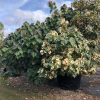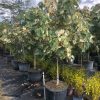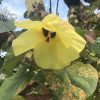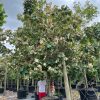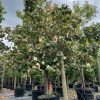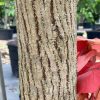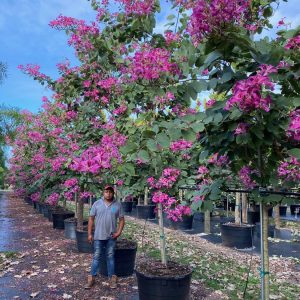Description
The tropical tree species Talipariti tilaceum ‘Variegata,’ often known as the variegated mahoe or variegated hibiscus, belongs to the Malvaceae family. It is a cultivar or hybrid of the common mahoe (Talipariti elatum) and is not typically found in the wild. Although it is believed that the variegated mahoe originated in the Caribbean, it is now common in tropical and subtropical areas worldwide.
Talipariti tilaceum ‘Variegata’ has a broad, rounded crown and a single trunk that is usually straight and thick, ranging from 11 to 15 inches in diameter. The tree’s bark is gray-brown in color and features deep furrows and cracks that run vertically along the trunk. It is a fast-growing tree that can reach heights of up to 65 feet.
Flowering and Foliage of Talipariti Tilaceum
The small, glossy leaves of the variegated mahoe (Talipariti tilaceum ‘Variegata’) have cream or yellow patterns and are arranged on broad, stout branches. There may be irregularities in the leaf variegation, with some leaves having more than others. Leaves are arranged in an alternate pattern along the branches, with a length of up to 4 inches and a width of up to 2 inches.
Moreover, the huge, colorful flowers of the variegated mahoe (Talipariti tilaceum ‘Variegata’) bloom in clusters from mid-summer to early fall. The hibiscus-like flowers are pink to purple in color, up to 15 centimeters in diameter, and have a distinct look. The tree’s fruit is a woody capsule with a rounded shape and fine hairs on top. This capsule breaks into a number of tiny, 2-millimeter-diameter, black seeds inside each fruit.
Soil Type and Plant Requirements of Variegated Mahoe Tree
The variegated mahoe (Talipariti tilaceum ‘Variegata’) thrives in soils with high moisture content and good drainage. Due to its ability to withstand salt spray, it is a good choice for coastal areas. Plus, because of its broad, round crown, variegated leaves, and spectacular, big flowers, it is a popular ornamental tree species in tropical and subtropical regions of the world.
Landscape Applications
In South Florida, the variegated mahoe (Talipariti tilaceum ‘Variegata’) is a common choice for landscaping because of its stunning variegated foliage and excellent resistance to coastal conditions.
In both residential and commercial settings, the variegated mahoe (Talipariti tilaceum ‘Variegata’) is a great accent tree. As it stands out in any garden thanks to its huge blossoms that contrast with the variegated leaves. And subsequently, the rest of the garden.
Furthermore, due to its dense leaves, it also works great as a windbreak or privacy screen. And is often planted near the coast to prevent erosion and boost the aesthetic appeal of the area.
Sometimes people confuse the common mahoe (Talipariti elatum) with the variegated mahoe (Talipariti tiliaceum ‘Variegata’). Nonetheless, despite being both members of the Malvaceae family, they are two distinct tree species. What primarily distinguishes them are the leaves. While the leaves of the variegated mahoe are smaller and variegated with cream or yellow lines. The leaves of the common mahoe are larger, dark green, and heart-shaped.
Other Common Uses
In addition to its ornamental value, variegated mahoe (Talipariti tilaceum ‘Variegata’) is also great for various purposes. Such as making rope and in traditional medicine. The tree’s leaves and bark contain therapeutic qualities that are ideal for treating a variety of conditions. Including fever, diarrhea, and respiratory infections.
🌳Other popular and beautiful plants: Ficus Aurea.



















